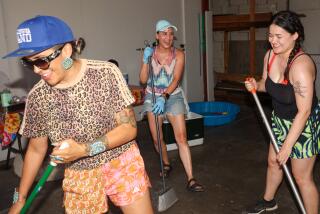Gay/Lesbian Arts Center Intends to Fill Vacuum : Culture: The response to a nonprofit umbrella corporation that will unite L.A.’s gay and lesbian artists is mostly positive.
After years of working in the arts, it began to disturb Paul Chirumbolo that, although there are many working gay and lesbian artists, there was no single organization to bring those artists together.
“The gay community . . . is disproportionately represented in the creative fields,” said Chirumbolo, a former marketing and advertising executive and working visual artist and screenwriter. “Only recently have people begun to ‘come out’ en masse. There is not a recognition in the general population that there has been a tremendous contribution . . . by gay men and lesbians.”
So, 14 months ago, Chirumbolo began developing the concept of a nonprofit umbrella corporation that would unite Los Angeles’ gay and lesbian arts community by providing studio space for existing arts institutions that serve the gay community.
*
Although a site has not been finalized for the Community Arts Center, and it won’t open until 1994, the idea is drawing mostly positive reactions from participating organizations, as well as local arts groups, such as Santa Monica’s Highways and Hollywood’s Celebration Theatre. Highways presents a wide variety of performances including some gay-themed work and Celebration Theater exclusively presents gay-themed theater.
“I don’t see it as being competition,” said Jordan Peimer, administrative director of Highways. “I think the queer community--I use the term because it is inclusive--really needs a cultural center. It would make L.A. much more of a queer mecca than it already is; it would probably put the city in line with San Francisco or Amsterdam.”
Ernie Lafky, co-director of a theater program for gay, lesbian, bisexual and transsexual homeless youth at the Los Angeles Gay and Lesbian Community Services Center, agreed. “It’s filling a kind of gap,” he said. “Especially since (gay issues) are such a hot topic right now, both culturally and politically. Look at (lesbian comic) Lea DeLaria appearing on Arsenio Hall, or (transvestite singer) RuPaul all over MTV. It’s the gay ‘90s.”
Chirumbolo, executive director of the center, has nine organizations--including the African American Gay & Lesbian Cultural Alliance, International Gay and Lesbian Archives, Artists Confronting Aids and the Gay and Lesbian Media Coalition Gay Men’s Chorus of Los Angeles--signed on to share space in a common facility. There are also 10 non-resident arts groups, principally gay-identified arts groups, that will be actively involved in facility usage. The center holds its first benefit Dec. 10 at downtown’s Glam Slam club.
Chirumbolo hopes the center will not only serve as a work space, but as a historical resource on gay and lesbian art history. The center is looking at several Hollywood and West Hollywood locations for the center.
Jim Kepner, founder and curator of the 51-year-old International Gay and Lesbian Archives now housed in West Hollywood, looks forward to moving the collection to the Community Arts Center. He is encouraged to see a gay center emerging that will focus on culture rather than medical and social services.
*
“For so long the gay movement was really focused on the idea of changing the law, there was almost a tendency to forget our cultural and social life,” Kepner said. “There have been prominent romantic novelists who hid the fact that they were black; there were women mystery writers who used their initials to hide the fact that they were women. Whenever you are in a group that is subject to stereotyping, getting rid of the hidden-ness is the ultimate necessity.”
Chirumbolo said the center will be “gay-identified, but not gay-exclusive.” Three of the nine resident organizations involved in the project--Ideas Associates, the Art 5P21 Arts Coalition and Words Across Cultures--are not gay-identified groups. Michael Fletcher, president of Ideas Associates, which develops artwork that heightens AIDS awareness, said his group decided to participate to increase the dialogue between gay and non-gay Angelenos.
While calling the establishment of a gay arts center essential, Luis Alfaro, project director of Viva!, a Latino gay and lesbian arts organization, said the group opted out because initial discussions with the forming board of directors led him to fear minority voices might get lost. “(We wondered): ‘Are we walking into something that is going to use our name and obviously use our color for grant purposes? And what are we going to get out of it?” he said.
Community Arts Center board member Edwina “Precious” Conley, a self-described “unpublished inner-city African-American lesbian poet,” is willing to take that risk. “Everything is ruled by white males--gay and straight,” she said. “I think if I don’t go forward to represent my cause, no one will.”
Paul Borden, executive director of Celebration Theatre, said that, although his theater will not join the center, he applauds the idea. He believes the development of other gay and lesbian arts centers in Los Angeles is a healthy sign that the gay arts community is “growing up.”
Borden added that any center that widens the pool of working gay and lesbian playwrights will facilitate a thematic move beyond the oft-told story of revealing homosexual identity to a shocked heterosexual community. “How many times can we do the ‘coming out’ musical?’ ” he reasoned.
“This is a community that really needs to see itself,” Borden added. “It’s not like any of us were brought up with really good role models.
“Here in L.A. . . . if you are invisible as a lesbian or a homosexual man, you are not doing your job. You are not showing the world that you are just as important a part of the community as anybody else is.”
More to Read
The biggest entertainment stories
Get our big stories about Hollywood, film, television, music, arts, culture and more right in your inbox as soon as they publish.
You may occasionally receive promotional content from the Los Angeles Times.










